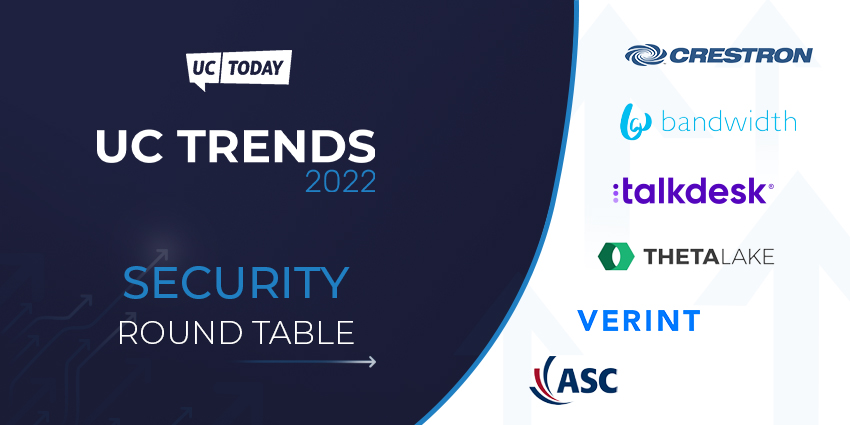For any business interested in upgrading their Unified Communication strategy, security will always be a critical consideration. Every conversation, whether via voice, video, or chat, is a transition of data which must be protected by the business. As the number of threats in the communication landscapes continues to grow, brands are under increasing pressure to rethink their security strategy.
Fortunately, there are tech solutions available to help today’s companies tackle their biggest safety and security issues. In this UC Security RoundTable, we reached out to Security innovators Talkdesk, Bandwidth, Crestron, Verint, ASC Technologies, and Thetalake, for their insights into the future of communications protection.
What are the Most Significant Customer Trends from 2021?
2021 has been an interesting year to say the least, with many companies finally beginning to explore new strategies for hybrid, remote, and flexible working following the pandemic. As some teams return to the office and others remain at home, new security trends have begun to emerge. Here’s what our experts had to say about the events of the year:
David Gardner, VP of Research, and Insights for Talkdesk:

After a complex year of adapting to a changing post-pandemic world, Talkdesk’s David Gardner believes 2021 is introducing a new era where customer experience needs to be considered more carefully and strategically.
“Digital transformation continues to be a key theme, companies are also looking to advance along the AI and automation maturity curve, and we’re seeing the contact center evolve from a cost center to an engine for customer retention, growing revenue, and driving a greater share of wallet”
Lydia Runnels, VP of Product Management for Bandwidth:
According to Lydia Runnels of Bandwidth, where 2020 companies forced companies to become more agile and flexible, 2021 saw people actually responding to that new demand by scaling the implementation of APIs and new tools in their communication stack.
“Such APIs have been used to alleviate manual work to manage employee workstations in the enterprise and better streamline number management processes for platform providers by enabling automated ordering and porting numbers of numbers, setting up of SIP trunks, and provisioning and managing of failover.”
As companies continue to embrace these new solutions, they will need to be careful in ensuring their adopted technologies align from a security perspective.
Brad Hintze, Executive VP of Marketing for Creston:
Crestron’s Executive VP, Brad Hintze believes the “Trusted Platform Module” technology in firmware and hardware is growing more important, particularly with new demand from the Windows 11 operating system, and an increased need for enhanced security.
“For those who don’t know this previously little-known security feature, a TPM is designed to provide hardware-based, security-related functions. By pressing the power button on a device that uses full-disk encryption and a TPM, the tiny chip will supply a unique code.” If the code isn’t normal, or there’s a problem with it, the system won’t boot up.
“TPMs don’t have to be a physical chip. They can also be integrated into the main CPU as code that runs in a dedicated environment, as firmware.”

Marc Gilman, General Counsel and VP of Compliance for Theta lake:
According to Theta lake’s Marc Gilman, investment in enterprise security tools offering higher levels of transparency into collaboration settings is on the rise. Companies want to prevent issues like Zoombombing, or allowing the wrong people access to meetings.
At the same time: “Work from anywhere as the new default business environment and a corresponding need to protect and secure collaboration tools across a diversity of locations.” Plus, increased awareness and use of AI-based security controls to scan chat, voice, and video for risks is on the rise. These tools can help to reduce the risk of sharing sensitive information or discussing confidential topics in the wrong environments.
Philip Fry, VP of Product Strategy, Verint Financial Compliance:
VP of Product Strategy for Verint, Philip Fry said a key focus area for Verint, and one of the areas where the company sees the largest trends is around the financial services industry. Clients in this sector need to be able to communicate securely within the compliance framework established by global regulators.
“Voice communications, previously seen as a standalone, un-structured technology, now needs to be closely aligned to all other digital communications and social media streams. Voice recording and IM capture need to be replaced with what we call “Human Compliance” – the ability to capture, archive, monitor, analyse and report at a user level rather than the current device level approach.”
Katrin Henkel, President of ASC Americas Inc:
President of ASC Americas, Katrin Henkel told us that moving traditional phone systems and PBX solutions into the cloud is a major trend, there’s a growing demand for mobile, flexible, and network communications prompted by home office activity in the last couple of years.
Additionally, IT and Communications are growing more closely connected, requiring new processes and strategies to be established. “The third wave of disruption in business communication is rolling: telephony, collaboration, and business applications are uniting to make integrated business communication. Easy & Smart Workflows: Extended functionalities and the integration of processes and compliance should be as intuitive and simple as possible. Staying compliant by all these technological developments require expertise & professional partners that provide consulting, solutions and services.”
What will be the top challenges facing end customers in 2022?
A changing landscape for communication, business interactions and teamwork present some unique risks and opportunities from a security perspective. In an age of hybrid work, where new tools are becoming more essential to business operations, certain challenges have begun to rise to the forefront. Here’s what our respondents had to say about the challenges that lie ahead.
David Gardner, VP of Research, and Insights for Talkdesk:
David Gardner told us that we’re living in a world where information security is a growing priority for companies and individuals alike. The rise of social engineering threats which manipulate users into disclosing private information is a growing area of concern. The contact centre appears particularly vulnerable to this kind of attack, due to the amount of sensitive information it stores to keep customers engaged.
Gardner notes companies need to make their teams aware of the threat of social engineering, while simultaneously installing the right technologies to protect against it.
“With contact center fraud on the rise, it’s important for organizations to keep their customer support professionals aware of the concept of social engineering and deploy the necessary strategies to prevent it as much as possible.”

Lydia Runnels, VP of Product Management for Bandwidth:
Bandwidth’s Lydia Runnels said increased security with regards to regulations and compliance is likely to be a challenge for companies going ahead. “It is expected that the frequency and complexity of regulatory change will only continue to increase globally. This has significant implications for customers operating in the domestic US and internationally. Customers are facing increased regulatory demands and partnering with vendors who can help them navigate the regulatory landscape and national and regional nuances will be increasingly in demand.”
Companies will also have the threat of security and fraud mitigation to consider. Even Bandwidth has been the victim of DDoS attacks launched against its networks in the past. CPaaS platforms are responsible for powering crucial communications, which means they have a good chance of being targeted. “
Brad Hintze, Executive VP of Marketing for Creston:
Executive VP Brad Hintze said a significant challenge is likely to come from companies attempting to make sure all of the extra devices in their business environments are managed and updated. If Microsoft sends a security patch or update for Teams, all devices need to be updated fast.
“The IoT-based provisioning and management service Crestron XiO Cloud is a powerful centralized tool that enables companies to deploy and manage thousands of devices in the same amount of time as it would to manage just one, without needing to go on-site. At the same time, the security increases since the IT team can check and push settings and firmware updates to minimize the risk associated with zero-day vulnerabilities.”
Brad also noted that uptime goes up because the company can check and monitor the status of devices anywhere and resolve events immediately.
Marc Gilman, General Counsel and VP of Compliance for Theta lake:
Theta lake VP Marc Gilman acknowledged the rising challenges companies will face to adhere to the new expectations and regulations of various industries. At the same time, organisations will need to overcome the risks of legacy compliance tools not built for the era of UC content.
Gilman predicted an “Uptick in security incidents like data exfiltration and inappropriate use of collaboration platforms.” And a failure to “secure, maintain, and monitor appropriate settings across the multiplicity of collaboration tools used within an organization” being important considerations in the years ahead.

Philip Fry, VP of Product Strategy, Verint Financial Compliance:
Philip Fry of Verint said that compliance isn’t generally the first thing on the mind of the end user, and it’s likely not something companies would list as being crucial to their essential investments in the years ahead.
However,
“The reality is that strong compliant solutions enable the wider utilisation of new world communications channels”
Katrin Henkel, President of ASC Americas Inc:
ASC Technologies’ Katrin Henkel said mobility devices and the growing demand for flexible workers is likely to be a major challenge in the years ahead. As companies become increasingly distributed and employees look into systems from anywhere, it will be crucial to ensure the right security strategies are in place.
“Mobile workforce needs solutions that give access whenever and wherever,” according to Katrin, but these solutions can’t come at the expense of security.
Which technology will deliver the greatest value to your customers in 2022?
As we look forward to the year ahead, there will doubtless be a number of opportunities for companies to take advantage of in the security landscape. Brands are beginning to settle into a new, more flexible environment for communication and collaboration, which means security concerns are becoming more obvious. We asked our experts for their opinions on what might deliver the greatest value to customers in 2022.
David Gardner, VP of Research, and Insights for Talkdesk:
Talkdesk’s David Gardner believes AI technology could be the crucial solution companies need in 2022, to master the changing security space. AI offers a range of opportunities for organizations to respond to a customer’s needs and wants seamlessly across all channels, with intelligent, personalized service, and even predictions of future needs or wants.
“While many AI systems require highly specialized data scientists, HITL technology allows customer service agents to improve AI models autonomously with clicks not code. This enables agents to manage inquiries smarter and faster, so they can focus on more impactful brand-enhancing and revenue-generating activities.”
Lydia Runnels, VP of Product Management for Bandwidth:
Lydia Runnels, the VP of Product Management and Bandwidth told us actionable insights and analytics are going to be two of the most important considerations for companies looking to upgrade their security standing.
At the same time, companies will be investing more in “Technology that enables global seamless, secure connectivity and API’s to assist in more seamless user experiences, and automation to remove friction from processes and porting.”
Brad Hintze, Executive VP of Marketing for Creston:

Crestron’s Brad Hintze believes significant benefits for the security communications will lie in the use of interactive dashboards providing real-world data analytics and usage insights. As more devices and technology continue to make their way into the business, companies need to have a clear overview of the security and status level of the devices they’re using.
“But with the shift to hybrid and while establishing what the new normal will be, it’s also vital for companies to understand how spaces are being used, and by how many people. Workplace analytics will provide enhanced dashboards allowing companies to best understand how rooms and systems are being used..”
Marc Gilman, General Counsel and VP of Compliance for Theta Lake:
Marc Gilman of Theta Lake said there are a number of technology trends primed to transform the future of communication security, starting with the cloud. The cloud environment offers the scalability and built-in functionality companies need to manage data at lower costs, without compromising on protection.
He told us:
“Collaboration security tools that identify risks across the video, voice, and chat features of collaboration platforms will be essential.” Additionally, companies will be looking for more “Flexible, easy to deploy security and compliance applications that can be used to identify collaboration platform risks across distributed workforces”
Philip Fry, VP of Product Strategy, Verint Financial Compliance:
Verint’s Philip Fry says that as financial institutions embrace new digital transformation strategies, UC vendors like Zoom, Microsoft and Cisco need to enable meeting requirements in their communication platform.
“Over the last twenty-four months the massive adoption of UC platforms was driven by the change in working processes due to the pandemic. The permanent evolution, however, will be based on a combination of regulations and flexibility. Whilst organizations are keen to reduce their own risk and costs by pushing the data into the cloud, actual rollout of these solutions will depend on the vendors ability to capture and archive communications, understand the use base, and be part of a wider communication architecture.”
Katrin Henkel, President of ASC Americas Inc:

Finally, Katrin Henkel noted that there are numerous potential avenues of transformational technology in the security space, from AI and speech analytics helping to process speech, while offering insight into sentiment, to proactive analytics.
“Today, Communication content can be effectively tagged, categorized, extracted, analysed, and transcribed without human involvement. This reduces potential compliance risks proactively”
Additionally, cloud technology is making it easier to install new solutions and flexibly control their tools without huge investments.







